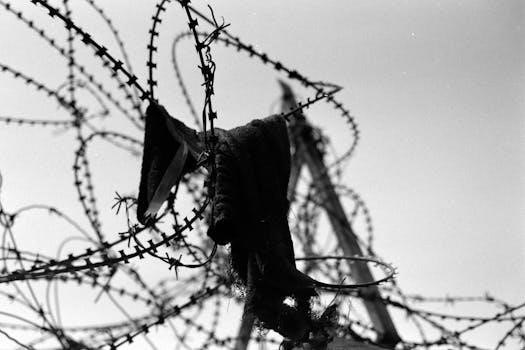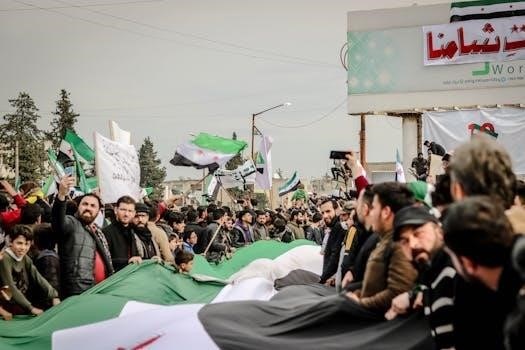
AQA Power and Conflict Poetry Anthology⁚ An Overview
The AQA Power and Conflict poetry anthology explores themes of power, conflict, and their effects across various contexts․ The collection features fifteen poems delving into power dynamics, war, identity, and social struggles․ Students analyze these works, examining poetic techniques and historical contexts to understand the poets’ messages․
Key Themes in the Anthology
The AQA Power and Conflict anthology explores profound themes through carefully selected poems․ These poems examine human experiences across different time periods and contexts, featuring fifteen key poems that delve into various aspects of power dynamics and conflict․ Themes include the abuse of power, the impact of conflict on individuals and societies, and the struggle for identity․
War is a prominent theme, portraying its brutality and psychological effects․ Social injustice and oppression are explored, highlighting inequalities and struggles for freedom․ The poems also delve into individual versus collective identity, exploring tensions between personal desires and societal expectations; Memory and the past play a role, shaping present experiences and understanding․ Ultimately, the anthology prompts reflection on the complexities of power and the enduring nature of conflict․

Detailed Analysis of Individual Poems
This section provides in-depth analyses of individual poems within the AQA Power and Conflict anthology․ Each analysis explores the poem’s context, structure, language, and themes, offering insights into the poet’s intentions and the poem’s overall meaning․
“Ozymandias”⁚ Power, Arrogance, and Decay
“Ozymandias,” penned by Percy Bysshe Shelley, intricately examines the fleeting nature of power and the inevitable decay of human ambition․ Inspired by the unearthing of Ramesses II’s statue, Shelley critiques the pharaoh’s belief in his god-like status and eternal legacy․ The poem uses irony to highlight the contrast between Ozymandias’s grandiose claims and the desolate reality of his ruined monument․
The “colossal wreck” symbolizes both the pharaoh’s ego and the statue itself, now consumed by time and nature․ Phrases like “boundless and bare” and “lone and level sands stretch far away” emphasize the desert’s triumph over human pride․ The irregular rhyme scheme mirrors the broken statue, signifying the disintegration of power․ Shelley presents a cautionary tale about the futility of earthly ambition and the enduring force of time, suggesting that arrogance ultimately leads to oblivion․
The poem serves as an allegory for the eventual end of all power, especially that of the proud․
“Kamikaze”⁚ Duty, Honor, and Societal Conflict
Beatrice Garland’s “Kamikaze” explores the complex interplay of duty, honor, and societal expectations through the story of a Japanese pilot who aborts his suicide mission․ The poem delves into the conflict between the pilot’s individual will to survive and the collective morals of Japanese culture, where kamikaze pilots were expected to sacrifice their lives for their country․
The use of impersonal pronouns (“he,” “his,” “him”) emphasizes the pilot’s alienation, as his family treats him as if he no longer exists due to the shame associated with his decision․ This shame and regret are further highlighted by the past tense in the final lines, “he was no longer the father we loved,” creating empathy for the pilot’s predicament․
Unlike “Ozymandias,” there is no hubris in the pilot’s portrayal, but he is equally bound to his mortality․ The poem questions the “better way to die,” leaving the reader to contemplate the pilot’s fate and the complexities of duty versus personal choice․
“London”⁚ Social Injustice and Oppression
William Blake’s “London,” published in 1794, is a powerful critique of social injustice and oppression in the city․ The poem presents a bleak picture of London, marked by poverty, suffering, and the abuse of power․ Blake uses vivid imagery and repetition to convey the pervasive sense of despair and moral decay․
The poem reflects Blake’s outrage at the terrible conditions he witnessed in London, where poverty and exploitation were rampant․ The French Revolution, with its ideals of liberty and equality, serves as an important historical context for the poem․ Blake’s use of language and structure emphasizes the cyclical nature of oppression and the hopelessness of the situation․
The poem’s exploration of themes such as the corruption of institutions and the suffering of the marginalized makes it a relevant commentary on social issues that persist even today․ “London” stands as a testament to Blake’s commitment to social justice and his condemnation of the forces that perpetuate inequality․
“Bayonet Charge”⁚ The Brutality of War
“Bayonet Charge” vividly depicts the brutal reality of war, focusing on a soldier’s experience in a chaotic and terrifying charge․ The poem captures the soldier’s loss of innocence and the dehumanizing effects of conflict, highlighting the physical and psychological trauma inflicted by war․ The poem explores themes of fear, confusion, and the loss of humanity amidst the violence of battle․
Hughes employs powerful imagery and visceral language to convey the soldier’s disorientation and terror, emphasizing the senselessness and futility of war․ The soldier’s transformation from a thinking individual to a mere cog in the war machine is a central theme, illustrating the destructive impact of conflict on human identity․
Hughes’s poem challenges romanticized notions of warfare, presenting a stark and unflinching portrayal of the true horrors experienced by soldiers on the front lines․ “Bayonet Charge” serves as a powerful anti-war statement, urging readers to recognize the devastating consequences of armed conflict․
“The Charge of the Light Brigade”⁚ Futility and Obedience
Tennyson’s “The Charge of the Light Brigade” recounts a disastrous military charge during the Crimean War, emphasizing the themes of futility and blind obedience․ The poem tells the story of six hundred soldiers who followed orders to charge into a heavily defended valley, resulting in significant casualties and highlighting the tragic consequences of unquestioning obedience․
Tennyson uses vivid imagery and a fast-paced rhythm to convey the chaos and intensity of the charge, while also underscoring the bravery and sacrifice of the soldiers․ The poem explores the conflict between duty and reason, questioning the wisdom of the command while honoring the soldiers’ courage in carrying it out․
The poem serves as both a tribute to the soldiers’ valor and a critique of the military leadership, suggesting that their blind adherence to orders led to unnecessary loss of life․ “The Charge of the Light Brigade” raises important questions about the nature of heroism, the responsibility of command, and the human cost of war․

Comparing Poems⁚ Common Themes and Contrasting Perspectives
Analyzing the AQA Power and Conflict poems involves comparing how different poets explore similar themes from diverse angles․ Poems like “Ozymandias” and “Kamikaze” both touch on fate, but “Ozymandias” uses irony to depict a ruler’s downfall, while “Kamikaze” offers a nuanced, personal view of an individual’s struggle against societal expectations;
Similarly, “London” and “Bayonet Charge” both depict the impact of conflict, but one focuses on social injustice and oppression, while the other portrays the brutal reality of war․ “The Charge of the Light Brigade” and “Kamikaze” present contrasting perspectives on duty and sacrifice, with one emphasizing obedience to command and the other exploring the conflict between personal will and societal pressure․
By comparing these poems, students can gain a deeper understanding of the complexities of power, conflict, and human experience, recognizing how poets use different techniques and perspectives to convey their messages․

Exam Preparation Strategies for the Power and Conflict Anthology
Effective exam preparation for the AQA Power and Conflict anthology involves several key strategies․ Firstly, prioritize revising all fifteen poems, focusing on understanding their key themes, contexts, and poetic techniques․ Create detailed notes and analyses for each poem, highlighting important quotes and their significance․ Practice comparing poems to identify common themes and contrasting perspectives, enhancing your ability to analyze and synthesize information․
Develop a strong essay structure using methods like PEEZAP (Point, Evidence, Explanation, Zoom, Analysis, Perspective) to ensure clear and well-supported arguments․ Familiarize yourself with relevant terminology to enhance the sophistication of your analysis․ Prioritize your top five poems for in-depth revision, ensuring you can confidently discuss them in detail․ Consider using knowledge organizers and quote sheets to consolidate your understanding and aid recall․
Finally, practice writing timed essays to improve your exam technique and time management skills, ensuring you can effectively address the exam questions within the given time frame․
The Significance of Context in Understanding the Poems
Understanding the context of the poems in the AQA Power and Conflict anthology is crucial for a comprehensive analysis․ Each poem is deeply rooted in its historical, social, and cultural background, which significantly influences its themes and messages․ Examining the context allows students to grasp the poet’s intentions and the deeper meanings embedded within the verses․
For instance, understanding the French Revolution is vital for interpreting Blake’s “London,” as it sheds light on the social injustice and oppression prevalent during that era․ Similarly, knowing about the Egyptian Pharaohs’ belief in their divine status enhances the understanding of Shelley’s “Ozymandias” as an ironic commentary on the fleeting nature of power․
The context of “Kamikaze” reveals the immense pressure on Japanese pilots to sacrifice their lives for their country, adding depth to the exploration of duty and societal conflict․ By exploring these contexts, students can develop a more nuanced and insightful understanding of the poems․
Essay Structure and Analysis Techniques (PEEZAP)
The PEEZAP structure is a useful method for structuring essays on the AQA Power and Conflict poetry anthology․ PEEZAP stands for Point, Evidence, Explanation, Zoom, Analysis, and Perspective․ This technique ensures a comprehensive and well-supported analysis of each poem․
Start with a clear Point related to the essay question․ Then, provide Evidence from the poem to support your point․ Explain the evidence in detail, highlighting key aspects of the language and structure․ Zoom in on specific words or phrases, analyzing their connotations and effects․ Next, provide a deeper Analysis of the poem’s themes and techniques․
Finally, consider the Perspective of the poet and the reader, exploring the poem’s context and intended impact․ Using PEEZAP helps students organize their thoughts, develop insightful interpretations, and craft compelling arguments․ It ensures a thorough exploration of the poems’ meanings and effects, leading to higher-quality essays and a deeper appreciation of the anthology․

Revision Resources and Study Guides
Effective revision for the AQA Power and Conflict poetry anthology requires utilizing various resources and study guides․ Many websites offer comprehensive notes, analyses, and contextual information for each poem․ These resources often include summaries of the poems, explorations of key themes, and discussions of poetic techniques․ Quote sheets can be invaluable for memorizing key lines and supporting essay arguments․
Knowledge organizers provide a structured overview of each poem, aiding in quick recall of essential information․ Exam summaries and timings help students manage their time effectively during the exam․ Prioritizing the top five poems for in-depth study can also be a strategic approach․ Consider using revision guides that offer practice questions, sample essays, and comparative analyses․
Online video lectures, such as those from MASSOLIT, provide expert insights into the poems․ By combining these resources, students can develop a thorough understanding of the anthology and improve their exam performance․